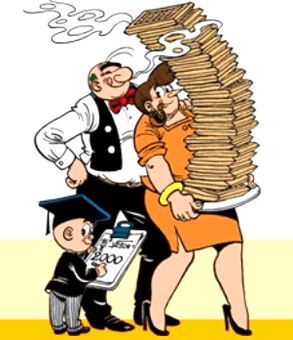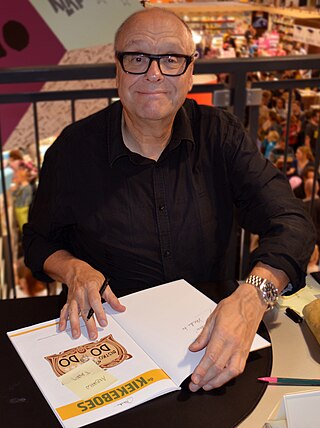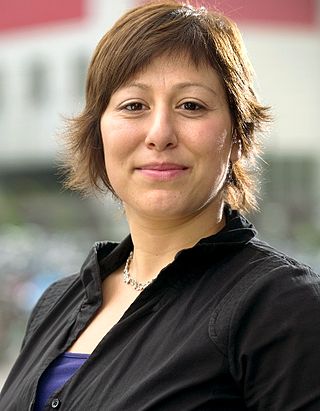
The Adventures of Nero or Nero was a Belgian comic strip drawn by Marc Sleen and the name of its main character. The original title ranged from De Avonturen van Detectief Van Zwam in 1947 to De Avonturen van Nero en zijn Hoed in 1950, and finally De Avonturen van Nero & Co from 1951. It ran in continuous syndication until 2002. From 1947 until 1993 it was all drawn by Sleen himself. From 1992 until 2002 Dirk Stallaert took over the drawing while Sleen kept inventing the stories.

Willebrord Jan Frans Maria "Willy" Vandersteen was a Belgian creator of comic books. In a career spanning 50 years, he created a large studio and published more than 1,000 comic albums in over 25 series, selling more than 200 million copies worldwide.
Miss Belgium is a national beauty pageant in Belgium. The winner of Miss Belgium automatically represents her country at the Miss World and Miss Universe pageants if the dates do not overlap.

De Rode Ridder is a Belgian Flemish comic book series set in medieval Europe. It stars the title character Johan, the Red Knight, easily recognizable by his red tunic. It appeared six days a week in the newspaper De Standaard and a few other ones.
Gilbert Declercq is a Belgian freelance painter, illustrator, and comics artist.
Maria, Baroness Rosseels, also known with her pen name "E. M. Vervliet", was a Belgian Catholic writer.

Merho, is a Belgian comic-book writer and artist, best known for creating the comic strip De Kiekeboes.
Patrick Conrad is a Flemish painter, poet, screenwriter and novelist, and one of the founders of The Pink Poets. He also directed about twenty movies for cinema and television, including – selected for the Cannes Festival - the international cult film Mascara. As a painter and collage artist he showed his Work in about 40 solo exhibitions in Belgium and France and three retrospective exhibitions of his work: in 1975, in 2005 and in 2022 in the Verbeke Foundation. His work is part of important private collections in France, Belgium, England, Scotland, Germany, Holland, Denmark, Australia and U.S. He lived 34 years in the south of France and moved in 2023 to Porto Alegre (Brasil). In Belgium he is represented by the Paul Verbeke galery which published an artbook about his work.

Faris Haroun is a Belgian former professional footballer who played as a defensive midfielder. He has also played for the Belgium national team.

Willem Marcel (Wim) De Craene was a Flemish Belgian singer. His most famous songs were 'Rozane' (1975), 'Tim' (1975) and 'Breek uit jezelf' (1988).

Walter Baele is a Flemish cabaretier and actor, best known for creating characters.

Meyrem Almaci is a Belgian politician from Flanders and member of the ecological party Groen. On 10 June 2007, she was elected to the Belgian Chamber of Representatives for the first time. She was re-elected in 2010 and in 2014 when she also became the president of Groen. In 2019 she left the Belgian parliament and was elected in the Flemish Parliament.

Marc Sluszny was an adventurer, sportsman, keynote speaker, mental coach and author. Through extreme sports he searched to overcome his mental and physical boundaries. He broke several records and participated many times in the European and World Championships in different disciplines. During the last few years, Marc focused on coaching executive teams and high-level athletes.

Charel Cambré is a Flemish Belgian comics artist and author.

F.C. De Kampioenen is a Belgian comic strip created by Hec Leemans since 1997 and published by Standaard Uitgeverij. The comics series is based on the television sitcom comedy series of the same name on Flemish television. The series ran for 94 albums with numerous special versions and editions.

Frans Jozef Peter van den Branden was a Belgian playwright, art historian, civil servant, educator and archivist. He wrote in the Dutch language. He is now known mainly for his art historical works, which mainly dealt with the history of the Antwerp school of artists and Antwerp poets and dramatists linked to the local chambers of rhetoric. He also co-authored the Biographisch woordenboek der Noord- en Zuidnederlandsche letterkunde with Johannes Godefridus Frederiks, a biographical dictionary of writers from the Netherlands and Belgium and their predecessor states.

Clara Cleymans is a Belgian actress and musical theatre singer.
The Masked Singer is a Belgian reality singing competition television series based on the Masked Singer franchise which originated from the South Korean version of the show King of Mask Singer. It premiered on VTM on 18 September 2020. The first two series were hosted by Niels Destadsbader. The winner of the first series was Sandra Kim. The winner of the second series was Camille Dhont. The third and fourth series are hosted by Jens Dendoncker. Aaron Blommaert and Francisco Schuster won the following seasons.

Big Brother is the Dutch & Belgian cooperation version of the international reality television franchise Big Brother produced by Endemol. The show aired in Netherlands on RTL5 and in the Flemish Region on VIER/Play4 and has had a total of four seasons. The first season of the show aired in 2021. A fifth season will air in 2025.
Notable events of 2023 in comics.
















